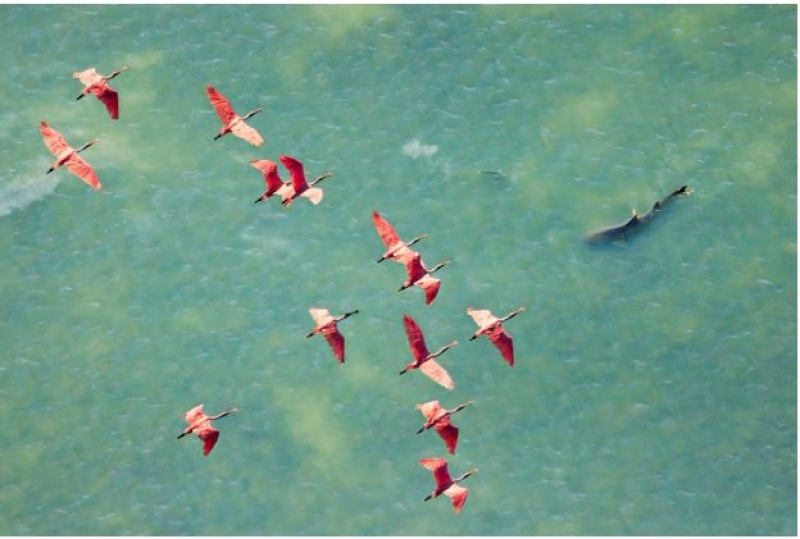- US Issues Travel Alert for Bangladesh Ahead of Election |
- Air ambulance carrying bullet-hit Hadi flies for Singapore |
- Can Dhaka’s arms recovery drive ensure peaceful polls? |
- ‘Unhealthy’ air quality recorded in Dhaka Monday morning |
- BD peacekeepers' deaths: UN chief calls Dr. Yunus, offers condolence |
Mangrove Photographer of the Year - overall winner
Birds’ eye view of the hunt, Mark Ian Cook, United States, North America

Mark Ian Cook - Mangrove Photography Awards
A flock of Roseate Spoonbills glide over a lemon shark hunting mullet in the shallow, mangrove-lined waters of Florida Bay.
“Historically, Florida Bay was the primary nestling region of the Roseate Spoonbill in the US, but this species is becoming increasingly rare there as sea level rise negatively impacts their important mangrove foraging habitat. This species feeds on small, estuarine fish which it captures with its odd, spoon-shaped bill. Spoonbills are tactile foragers, meaning they feed by touch. As they forage, they sweep their bill from side to side in the water holding it slightly open so it creates a negative pressure that effectively sucks any small fish it encounters into the bill. However, for this foraging method to be successful the birds need relatively shallow water with very high densities of fish. This becomes particularly critical during the energetic bottleneck of the nesting season when the birds need to feed not only themselves but also 2 or 3 rapidly growing nestlings. High densities of fish are produced in the dry season when water levels decline, the area coverage of water in the mangroves shrinks, and fish become concentrated in increasingly smaller and shallower pools. Once a threshold depth of about 13 cm is reached the spoonbills can feed effectively and start nesting. However, with climate-change induced sea-level rise, these critical lower water depths in the mangroves are increasingly failing to be met, fish densities are insufficient for effective foraging, and fewer birds are able to breed.”
Judges Quotes:
Shin Arunrugstichai
What a scene! I love the convergence of all the elements in that exact moment. It clearly shows the diversity of life that lives and dies, both aerial and aquatic in the same space and time, that all depends on the mangrove ecosystem.
Tanya Houppermans
This is an extraordinary perspective showing just how dynamic mangroves can be. What makes the photo especially impressive is that while there is a lot of action taking place with the flight of the spoonbills and the predation by the lemon shark, the brilliant multi-layered composition allows the viewer to take it all in without being overwhelmed. Really an exceptional image!
Chien Lee
From a purely aesthetic standpoint, there are many aspects of this image that make it stand out: the unusual perspective, the contrasting and vivid color palette, and perhaps most of all the remarkable timing of the composition. Separate images of the spoonbills or hunting shark would be compelling even alone, but together they tell a story of the wealth of organisms that utilize the shallow of these ecosystems - both above and below the surface.

